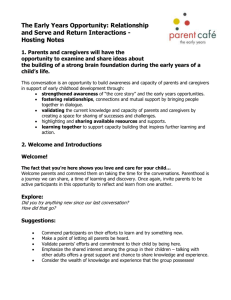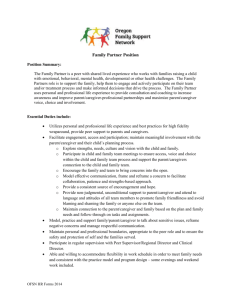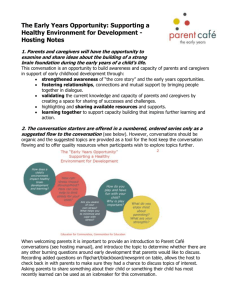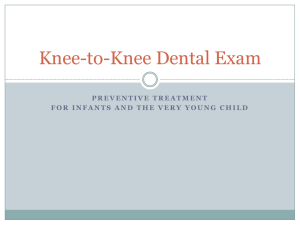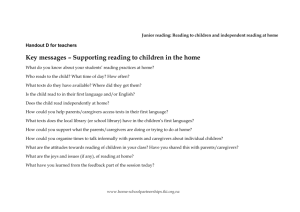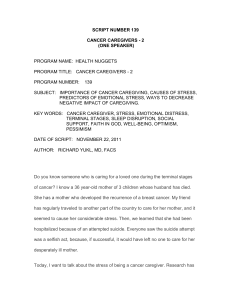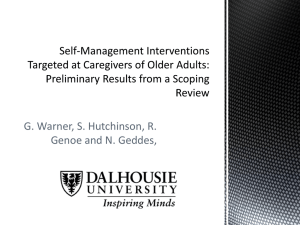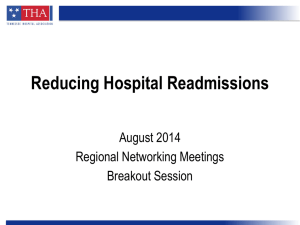Longitude - the arc or portion of the earth`s equator
advertisement
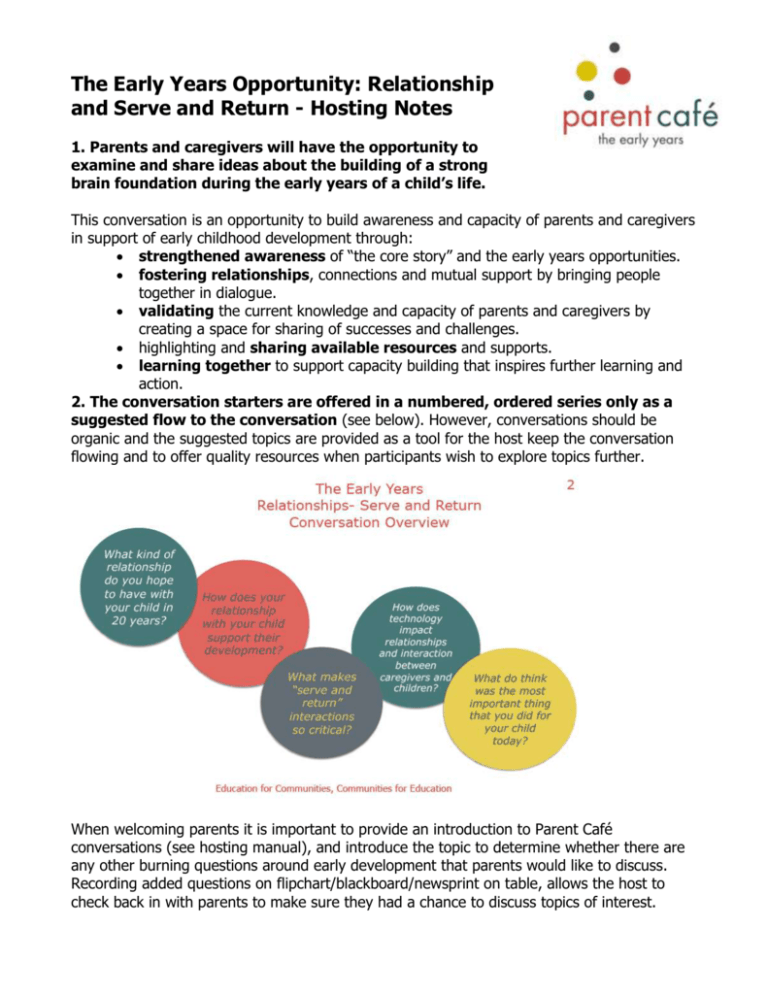
The Early Years Opportunity: Relationship and Serve and Return - Hosting Notes 1. Parents and caregivers will have the opportunity to examine and share ideas about the building of a strong brain foundation during the early years of a child’s life. This conversation is an opportunity to build awareness and capacity of parents and caregivers in support of early childhood development through: strengthened awareness of “the core story” and the early years opportunities. fostering relationships, connections and mutual support by bringing people together in dialogue. validating the current knowledge and capacity of parents and caregivers by creating a space for sharing of successes and challenges. highlighting and sharing available resources and supports. learning together to support capacity building that inspires further learning and action. 2. The conversation starters are offered in a numbered, ordered series only as a suggested flow to the conversation (see below). However, conversations should be organic and the suggested topics are provided as a tool for the host keep the conversation flowing and to offer quality resources when participants wish to explore topics further. When welcoming parents it is important to provide an introduction to Parent Café conversations (see hosting manual), and introduce the topic to determine whether there are any other burning questions around early development that parents would like to discuss. Recording added questions on flipchart/blackboard/newsprint on table, allows the host to check back in with parents to make sure they had a chance to discuss topics of interest. 3. For you, what was most important about our last conversation? Have you done anything since? Creating a summary of key points from the last discussion is an opportunity to clarify questions, reinforce key points and summarize for parents that weren’t part of the first discussion. Suggestions: What made the biggest impression? What sparked you to try something new? Did you have the chance to share this information with others? Collecting the ideas that parents felt were most important as well as ways that they have integrated ideas and responded can spark further discussion and exchange. Recording these ideas can be helpful for further reflection and is very important for monitoring the impact of the conversations. You may want to review the short video, particularly if there were parents that were not at the first conversation: How Brains are built: The Core Story of Brain Development as a starting point for the conversation. Reviewing the key points from “The Core Story”: • Brains are born and then built, based on our experiences. While our genes determine the timing and sequencing of brain development, our experiences and environment will shape how this unfolds • Brains are built from the bottom up, with early skills supporting later more complex skills, so its easier to get it “right the first time”. The “foundation” of the brain is built in the early years of a child’s life and impacts development in all areas. • Stress can cause changes to the brain that leave a child at risk for behavioral and learning challenges and as well as physical health concerns throughout their life. • Serve and return interactions between a child and caregiver are the bricks to build a healthy brain foundation! Development happens in the context of relationship! • A child’s “air traffic control system”, their executive function and self-regulations skills need to be up and running as soon as possible. • Children can’t do this on their own! Parents play an essential role helping their child to reach their optimal development. Communities and our society have a responsibility too. Additional suggested resources: Early Brain Development 01 from the BBC 4. What kind of relationship do you hope to have with your child in 20 years? All parents want healthy and strong relationships with their child. By looking ahead to what we hope our relationship will be like in 20 years we might inspire a shift in perspective. The everyday opportunities that we have to connect and build relationship might be seen as more valuable. Some examples: I want an open and loving relationship with my child I want my child to be able to come to me when they have problems I want a relationship of support and mutual respect. Others… Explore: How can you support and build this key relationship? From the time you get up, what can you be doing? There are many ways that parents support and build healthy relationship with their child: Consistent, nurturing care-giving is a necessity for all young children. Taking time to give full attention enables us to engage in a nonverbal, emotional exchange. In this way care-givers communicate with a child, even before they can speak, and help them feel secure and understood. Nonverbal cues remain important ways of communicating with children. As children develop their verbal skills we begin to use language to understand and communicate. To really build relationship we need to really listen, and take time to “talk to” rather then just “talk at”. One study showed parent spent an average of 7 minutes a week in real conversation rather than directional language (source: Staying Connected). Spending time sharing a favorite activity (reading, singing, playing) and sharing in their interests will convey to a child that we value them for who they are. Of course, having fun together is great for all our relationships. “Think of your relationship as a bank account. In more challenging times you might need to make a withdrawal. Take advantage of opportunities to make deposits whenever possible.”“In real estate it is ‘Location, location, location’; in child development it is ‘Relationship, relationship, relationship!’’” Suggestion: Share and discuss Winning ways to talk to young people. -Washington State Department of Health and Social Issues. 5. How does your relationship with your child support their development? Explore: Some people refer to relationships as the “active ingredient” for early childhood development! Relationships between parents/caregivers and children are key to healthy development. “Attachment” is the word used to describe the emotional bond between infants and parents or caregivers. Secure attachments are formed through the emotional bonding that happens when parents care for their child and respond to their need, building trust and a sense of security. Attachment begins even before birth and plays an important role in brain development! While a child may not consciously remember, their early life attachments are processed by the limbic system, and stored as emotional memory. During the sensitive periods of brain development, healthy attachments actually contribute to shaping the architecture of the brain! Secure attachments also contribute to creating the safe environment that children need to learn and grow, impacting their self-confidence and independence and contributing to less stress reactivity and better relationships throughout their life! “A positive, nurturing relationship with a caregiver is one of the most important ways to promote and support the healthy social, emotional, and cognitive development of a young child!.” Healthy development happens in the context of this all important relationship! We know that stress can have negative effects on a developing brain but the consistent, positive care-giving in an environment of relationship and attachment can buffer a child from this toxic effect!This discussion may lead into the next question focused on experiences, highlighting the importance of serve and return interactions. Suggestions: Explore and share: Staying Connected: Child and family therapist Jennifer Kolari explains how positive parenting stimulates the production of oxytocin in a child's brain and how that benefits the child and the parents Science in Seconds: Early Brain Development from the Alberta Family Wellness Initiative site provides a summary of how relationships build brains and can protect young children from the effects of toxic stress. This video may be appropriate to share during your conversation. Relationships - “Think of it as brain food.”! 6. Explore together a short video from the Center on the Developing Child, Harvard University: Serve and Return Interaction Shapes Brain Architecture Explore: What are your reactions? What strikes you the most? Why are “serve and return” interactions between a child and caregiver so important for building a healthy brain? Serve and return interactions between a child and a caregiver are the back and forth interactions and communication that happen through eye contact, touch, singing, talking and games. Repeated over the course a child’s early years, these interactions actually provide the “bricks” to build a healthy foundation for future development! What’s makes “serve and return” interactions so special? They are part of an ongoing caregiver – child relationship, are responsive to child reaching out and to the individual child and their developmental needs, they build on child’s interests and current capabilities, and shape the child’s self-awareness and sense of who they are in the world. Serve and return interactions buffer a child’s stress response and are essential prerequisites for the development of healthy brain circuits and more complex skills! Suggested resources: Review the video: Three Core Concepts in Early Development, Experiences Build Brain Architecture from Harvard University’s Centre on the Developing Child. Washington State Department of Health Explore the Center on the Developing Child – Harvard University’s Serve and Return Interaction Shapes Brain Circuitry. From AFWI, the article Early Experiences & Gene Expression relates serve and return interactions to how genes our expressed! 7. “Serve and return” interactions between a child and caregiver are essential for building a healthy brain. What makes them so critical and unique? Responsive, ongoing, “serve and return” interactions are critical and unique because they… Are part of an ongoing caregiver – child relationship. Are responsive to child reaching out. Are responsive to the individual child and their developmental needs in the moment. Build on child’s unique interests and capabilities. Shape the child’s self-awareness and sense of who they are in the world Buffer from stress response. Are an essential prerequisite for the development of healthy brain circuits and more complex skills! Are a key ingredient in forming relationships between young children, their parents and other caregivers, promoting healthy social, emotional, and cognitive development. “When we respond appropriately, the child learns to form secure attachments, explore her world, control emotions and care about other people. At the same time, we learn about our children by watching how they respond to new experiences, new people and new places.” -Alberta Government Chief Medical Report “Let’s talk about the Early Years” Explore with parents: When did you and your child “serve and return” today? What did this look like? Some examples: During bath time we were making faces When changing her diaper she was smiling and I was smiling back We were playing peek-a-boo and making funny expressions 8. Technology is everywhere. How does technology impact relationships and interaction between caregivers and children? Much has changed in the last decade. Media and “screens” are now pervasive in our society. Parents today must make choices about how, when and how much media they and their child will consume. With iPods, iPads and other personal devices, children can consume hours of media each day, from a very young age. Parents are generally motivated with best intentions, but studies have shown that educational videos do not support language or other learning. We know that children learn words best when interacting face to face. Studies have shown that screen time can affect the number of words a child learns by Grade 1, and for every hour of passive (non-interactive) screen time, children understand and use fewer and fewer words (AHS - Healthy Parents Healthy Children). Media images can also be over-stimulating for children and can be stressful for young children, some even making links between media and the development of attention challenges. Children interacting with technology may be losing the opportunity for active exploration, physical activity and of course serve and return interactions – know to be real learning, brain-building activities. The Canadian Pediatric Society’s recommends no screen time for children under 2 and less than 1 hour per day for children 2-4 years of age. This is in stark contrast to the amount of screen time many children are now consuming. The CPS sedentary behavior guidelines also recommend caregivers minimize the time infants, toddlers and preschoolers spend being sedentary for more than 1 hour at a time. Of course, entertaining, captivating media can promote sedentary behavior. See: Healthy Parents Healthy Children – Screen Time, Alberta Health Services The CPS Physical Activity guidelines for healthy growth and development suggest infants (<1 yr of age) should be physically active several times daily – particularly through interactive floor-based play. Toddlers (1-2 yrs) and preschoolers (3-4 yrs) should have at least 180 min of physical activity spread throughout the day, with a variety of activities in different environments and develop movement skills. By the age of 5 years children should have at least 60 minutes of energetic play, with more daily physical activity provides greater benefits. A parent’s use of screen time also impacts how they connect with their child. Parents and caregivers absorbed in their own devices will be unlikely to “catch” a young child’s serve! While there may be some skills and knowledge that are built and supported using media we need to ensure that technology isn’t “getting in the way” of these other activities that we know are important contributors to healthy development. When technology is used with older children, it is best to ensure that it is a learning asset by: Sharing the experience with your child and talking about it Ensuring it is developmentally appropriate Using media for entertainment “wisely” – this might include making a plan and setting limits. Resources: Media and Children TED talk by Dr.Dimitri Christakis explores early brain development, the link between media and attention challenges and advocates for more real time play. 9. Reflecting on what we have discussed today… What do think was the most important thing that you did for your child today? We know that parents want the best for their child! This can be an opportunity to have parents make a connection between their day to day activities and interactions and validate how they are already supporting their child’s healthy development. Hearing ideas and responses from others can help parents and caregivers can be motivating and build confidence and capacity. Examples: Sang together while making breakfast. Played “peak-a-boo” while changing their diaper. Stayed for a few minutes to calm my child when they arrived at child care. Took a deep breath before responding when I felt frustrated. Others? Parents support the healthy development of their child in so many ways! They impact their child through their relationships, the environment they support and create, providing for physical needs to be met and of course opportunities for rich experiences and interactions. Some examples that parents might share include: • • • Providing an environment that meets the physical needs of the child, is secure and predicable and includes a consistent, loving caregiver - Examples: nap times, bed time routines, healthy food… Providing a caring, stable relationship, with consistent, positive interactions, responding to the child’s needs - Examples: comforting a crying child, spending time together… Providing opportunities for learning through “serve and return” interactions and exploration and play - Examples: playing peek-a-boo, babbling back and forth, taking turns, answering “why” questions, “floor time”, going for a walk and talking about what you see… Suggested Resource: View Promoting Healthy Brain Development: You can Make a Difference for further examples and background information for the host. 10. After our discussion today, would you like to set a goal or try something new to? What would you like to share with another parent or caregiver? Great ideas from parents: I will limit my child’s screentime. Check out the Harvard’s Center for the Developing Child. I will think more about my relationship with my child – and practice serve and return. Share the video with my family and childcare provider. Others? Reminder: provide any follow up information requested… Remember: “It takes a community to raise a child. The first 2000 days of a child's life is a time of tremendous growth and learning. The early years set the course for a child's future and we want that future to be the brightest possible!” source: Ready 4 Learning

